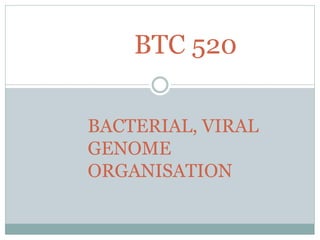
BTC 520 - Bacterial, Viral Genome Organisation
- 2. GENEORGANISATION • The word “genome,” coined by German botanist Hans Winkler in 1920, was derived simply by combining gene and the final syllable of chromosome. • An organism’s genome is defined as the complete haploid genetic complement of a typical cell. • In diploid organisms, sequence variations exist between the two copies of each chromosome present in a cell. • The genome is the ultimate source of information about an organism.
- 3. PROKARYOTES AND EUKARYOTES GENOME Prokaryotes Eukaryotes Single cell Single or multi cell No nucleus Nucleus One piece of circular DNA Chromosomes No mRNA posttranscriptional modification Exons/Introns splicing
- 4. CHROMOSOMEDIFFERENCE [PROKARYOTICANDEUKARYOTICCELL] PROKARYOTICCELL Lacksamembrane bound nucleus. Circular DNAand supercoileddomain. Histones not present. Prokaryotic genomesgeneraly contains one largecircular piece of DNArefered to asaCHROMOSOME. Somebacteria havelinear chromosome. Many bacteria havesmal circular DNAstr.CaledPLASMIDS which can be swapped between neighbours and across bacterial species.
- 5. Procaryotic genomes Generally 1 circular chromosome (dsDNA) Usually without introns Relatively high gene density (~2500 genes per mm of E. coli DNA) length of E.coli genome: 1.7 mm Often indigenous(natural) plasmids are present
- 6. Plasmids Extra chromosomal circular DNAs Found in bacteria, yeast and other fungi Size varies form ~ 3,000 bp to 100,000 bp. Replicate autonomously (origin of replication) May contain resistance genes May be transferred from one bacterium to another May be transferred across kingdoms Multicopy plasmids (~ up to 400 plasmids/per cell) Low copy plasmids (1 –2 copies per cell) Plasmids may be incompatible with each other Are used as vectors that could carry a foreign gene of interest (e.g. insulin) -lactamase ori foreign gene
- 7. PLASMID o The term plasmid was first introduced by the American molecular biologist Joshua Lederberg in 1952. o A plasmid is separate form, and can replicate independently of, the chromosomal DNA. o Plasmid size varies from 1 to over 1,000 (kbp).
- 8. Classification andtypesof PLASMID •Plasmids can be broadly classified into conjugative plasmids andnon-conjugative plasmids. •In the complexprocessof conjugation,plasmid may be transferred from one bacterium to another via sexpili encodedby someof the tragenes(transfer operon). •Non-conjugative plasmids are incapable of initiating conjugation, hence they can be transferred only with the assistanceofconjugative plasmids.
- 9. Another way to classify plasmidsisby function. Thereare five mainclasses: • Fertility F-plasmids,which contain tragenes.Theyarecapable of conjugation andresult in the expressionofsexpili. • Resistance(R)plasmids,which contain genesthat provide resistanceagainstantibiotics or poisons. • Colplasmids,which contain genesthat code for bacteriocins(p), proteins that cankill other bacteria. • Degradative plasmids, which enable the digestion of unusual substances, e.g. toluene(aromatic hydrocarbon) and salicylic acid(aromatic acid) • Virulence plasmids, which turn the bacteriumintoapathogen.
- 10. Bacterial genes Most do not have introns Many are organized in operons: contiguous genes, transcribed as a single polycistronic mRNA(bac and chloroplast mrna), that encode proteins with related functions Polycistronic mRNA encodes several proteins
- 11. Viral genomes Viral genomes: ssRNA, dsRNA, ssDNA, dsDNA, linear or ciruclar Viruses with RNA genomes: •Almost all plant viruses and some bacterial and animal viruses •Genomes are rather small (a few thousand nucleotides) Viruses with DNA genomes (e.g. lambda = 48,502 bp): •Often a circular genome. Replicative form of viral genomes •all ssRNA viruses produce dsRNA molecules •many linear DNA molecules become circular Molecular weight and contour length: • duplex length per nucleotide = 3.4 Å • Mol. Weight per base pair = ~ 660
- 12. VIRALGENOME A virus has either a DNA or an RNAgenomeandiscalled aDNAvirusor an vast majority genomes. Plant RNA virus, respectively. The of viruses RNA viruseshavetendtohave single-stranded RNA genomes and bacteriophages tend to have double-strandedDNAgenomes.
- 13. Mitochondrial genome (mtDNA) Multiple identical circular chromosomes Size ~15 Kb in animals Size ~ 200 kb to 2,500 kb in plants Over 95% of mitochondrial proteins are encoded in the nuclear genome. Often A+T rich genomes. Mt DNA is replicated before or during mitosis
- 15. Mitochondrial DNA contains 37 genes, all of which are essential for normal mitochondrial function. Thirteen of these genes provide instructions for making enzymes involved in oxidative phosphorylation. Oxidative phosphorylation is a process that uses oxygen and simple sugars to create adenosine triphosphate (ATP), the cell's main energy source. The remaining genes provide instructions for making molecules called transfer RNA (tRNA) and ribosomal RNA (rRNA), which are chemical cousins of DNA. These types of RNA help assemble protein building blocks (amino acids) into functioning proteins.
- 16. Chloroplast genome (cpDNA) Multiple circular molecules Size ranges from 120 kb to 160 kb Similar to mtDNA Many chloroplast proteins are encoded in the nucleus (separate signal sequence)
- 17. “Cellular” Genomes VirusesProkaryotes Eukaryotes Viral genome Bacterial chromosome Plasmids Chromosomes (Nuclear genome) Mitochondrial genome Chloroplast genome Genome: all of an organism’s genes plus intergenic DNA Intergenic DNA = DNA between genes Capsid Nucleus
- 18. Size of genomes Epstein-Barr virus 0.172 x 106 E. coli 4.6 x 106 S. cerevisiae 12.1 x 106 C. elegans 95.5 x 106 A. thaliana 117 x 106 D. melanogaster 180 x 106 H. sapiens 3200 x 106
- 19. KARYOTYPE o The study of chromosomes, their structure and their inheritance is known asCytogenetics. o Each species has a characteristic number of chromosomes and this is known askaryotype.
- 21. GENES–GENETICINFORMATION • One gene : one enzyme hypothesis: summarizes that a gene is a stretch of DNA coding for one or more isoforms of a single enzyme.(Beadle 1941) • One gene : one polypeptide hypothesis: a gene is responsible for the production of a single polypeptide.(Beadle 1945)